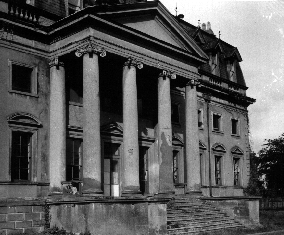Garendon Park
A short history
Notes drawn from various sources. Various books, newspaper articles and photographs are available in Loughhborough Local History Library,
Granby Street.
Garendon was founded in 1133 as a Cistercian Abbey by the Earl of Leicester.
The Abbot had a seat in parliament for a time.
The monastery was given various property around Loughborough during the middle ages until, by the 16th century it commanded land for miles around.
| In 1536 the abbey church was demolished on the orders of Thomas Cromwell as part of
his programe known as the disolution of the monasteries. A visit made to the monastery the year before had brought
charges of corruption and vice, typical of such inspections. The king, Henry VIII, gave the house and site of the abbey to the Earl of Rutland
shortly afterwards. The Cistercian house was then destroyed to build the first Garendon Hall.
Some of the stone can be detected in the walls surrounding the Park.
The Hall remained in the hands of the Earl of Rutland until 1632 when it was passed as a dowry to the royalist, the Duke of Buckingham.
During the Civil War a legend emerged surrounding the large pool at the northern end of the Park. For four days the water became deeper and deeper red. Cattle refused to drink and great clots, that had the appearance of blood, rose and fell in the water. Local people decided that the four days of blood must represent the four years of civil war, and named the pool the Bloody Pool thereafter.
|  |
Some fifty years later, in 1683, it was purchased for £28,000 by Ambrose Phillips, a lawyer and Sergeant of Charles II, for Judge Jeffreys.
However, Phillips liked it so much he kept it for himself, but not before Buckingham had cut down some £5,000 worth of timber.
Phillips improved the 420 acre Garendon Park by building and planting.
These 17th Century plans have remained until today only an aspiration of the land owners.
It was Sir Ambrose Phillips' grandson, also named Ambrose, who built the monuments, including the 80 foot Obelisk, which adds splendour to the Park today.
Built around 1735, the Triumphal Arch is a reproduction of the Arch of Titus in the Roman Forum whilst the Temple of Venus was inspired by the Temple of Sibyl at Tivoli.
Garendon Hall was rebuilt during the latter half of the 18th Century by Ambrose's brother Samuel. The Park then passed, by marriage, into the March family, who adopted the name March Phillips, later adding the name de Lisle, from a previous marriage.
The new Hall was a fine example of Palladian architecture with the facade being flanked by gateways based on a design by Inigo Jones. Benjamin Disraeli visited Garendon shortly before writing, Coningsby (1844), his first political novel in which the Park is described.
The family became Catholic in the 19th century and parted with the parish churches of Shepshed, Hathern, Thorpe and Dishley. Ambrose Phillips presented lands on which Mount St Bernard's Abbey was later built, to the Cistercian Order in 1835.
The Temple of Venus was originally planned as a chapel, but later housed a small art gallery until the paintings were removed
at the beginning of the second world war.
The Hall was billeted by troops in the warand also housed Italian prisoners of war. Although it was re inhabited by the de Lisle's in 1955, in May 1964
it was pulled down by the owner and it is said that the masonry was used to build the motorway.
The summer-house with pedimentoed portico had been destroyed during the war. One of the gateways, after Inigo Jones, survives today.
Despite being outside Loughborough, Garendon Park has always had close links with Shepshed. It was the venue for annual 'treats' and Sunday school outings, and during the war local girls would walk out along the Coach Road with soldiers based in the Park.
Although the motorway took a route along the western edge of the Park, it did cut through Home Covert wood,
isolating the Lodge at Cow Hill on the edge of Shepshed. An older lodge (1847) is close to Snell's Nook on the Ashby Road and another on
the Loughborough Road in Hathern. The Coach Road into the Park from Shepshed is still usable under a motorway bridge.
The Bavarian Gate (or Red Arch), built in 1838 by William Railton, is the finest gate to the Park and is found at the intersection of
paths between the Hathern Drive, the Back Lane from Loughborough and Butthole Lane from Shepshed. It is also currently a private residence.
In the last century the park within its ancient granite wall was set down as a deer park, with fallow deer for hunting.
The deer are gone but the walls remain and these, along with the monuments, dovecote and barn, are protected by DETR listing. Garendon Park is a Grade II
historic Park. It is protected by by Historic England as defined under the Historic and Ancient Monuments Act. In 1932 the Deer Park was proposed by the Leicestershire Regional
Town Planning group as a suitable open space to match Bradgate Park and raise the provision of recreational land in the north of the County.
Garendon Park is the breeding and feeding ground to many birds, from the tiniest Goldcrest to the largest Grey Heron.
It is also home to many animals and rodents, timid of humans or nocturnal of nature.
Garendon Park is one of Leicestershire's finest ancient parklands.
Some important links
Garendon Park Leics Gardens Trust
Garendon Development
A detailed description
Lynne About Loughborough
Last updated April 2024
